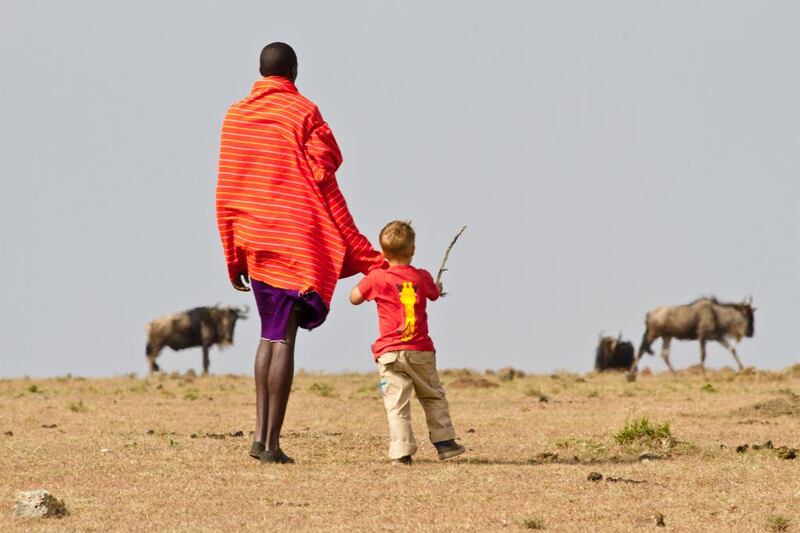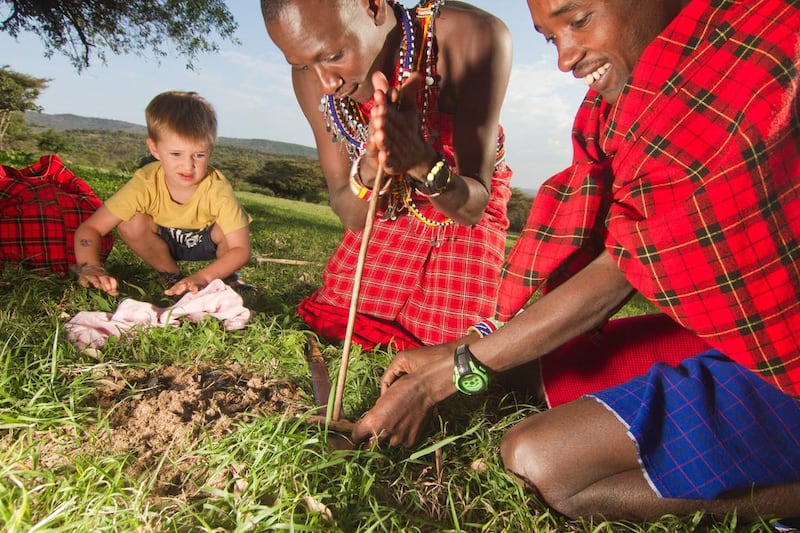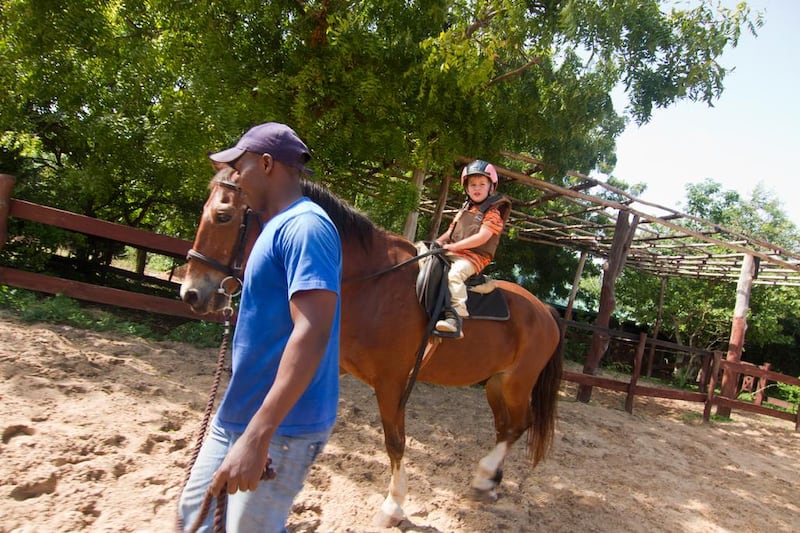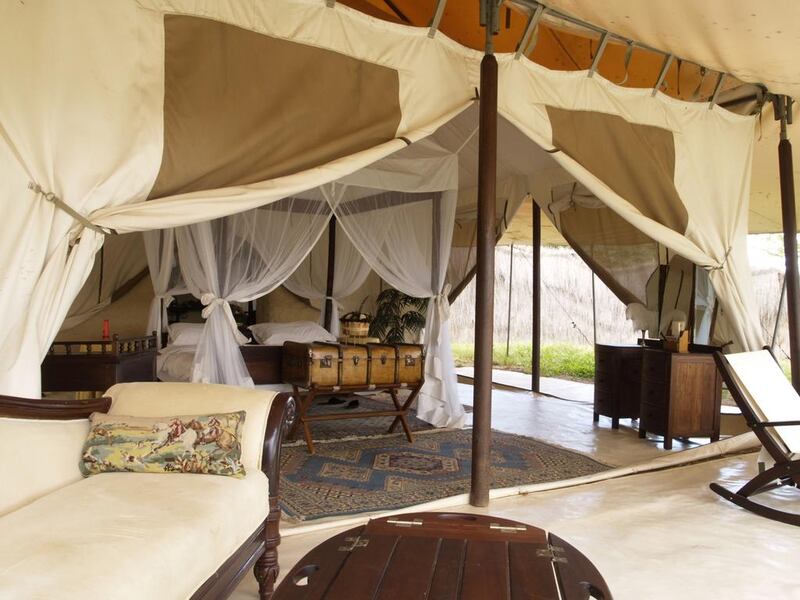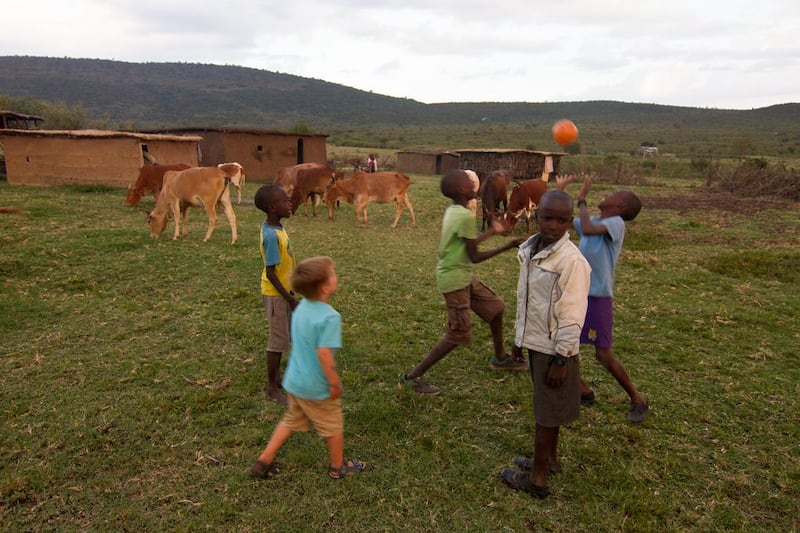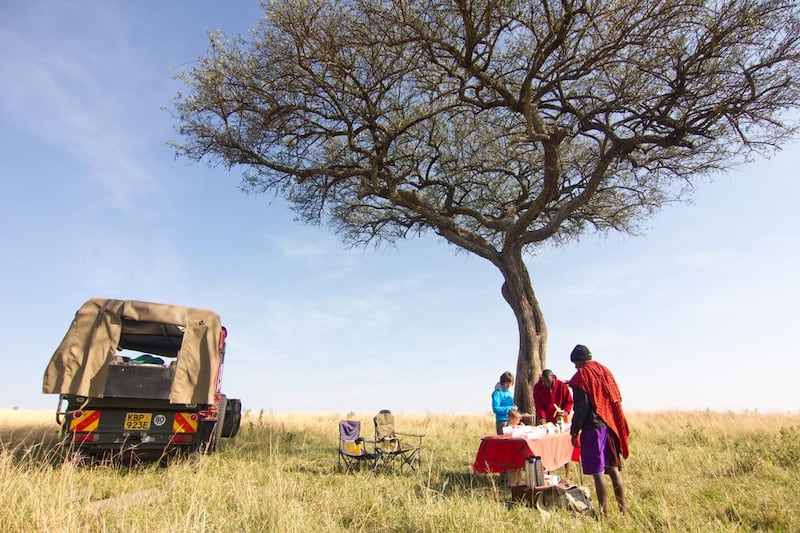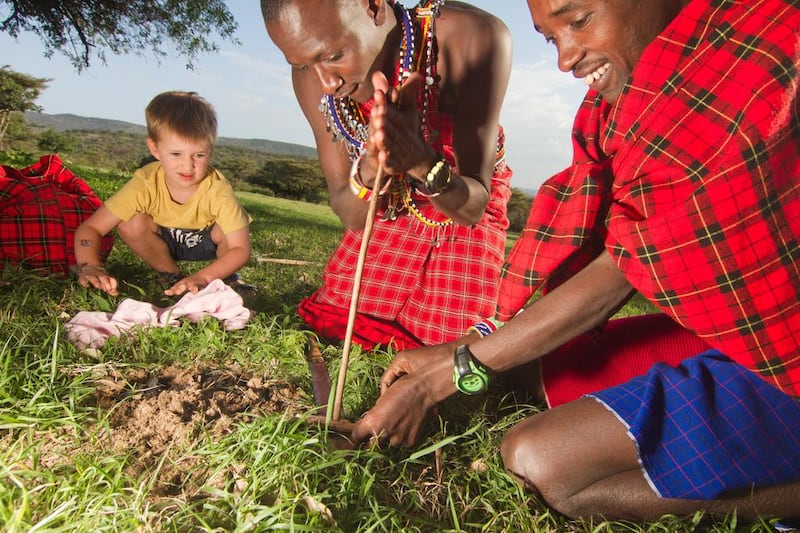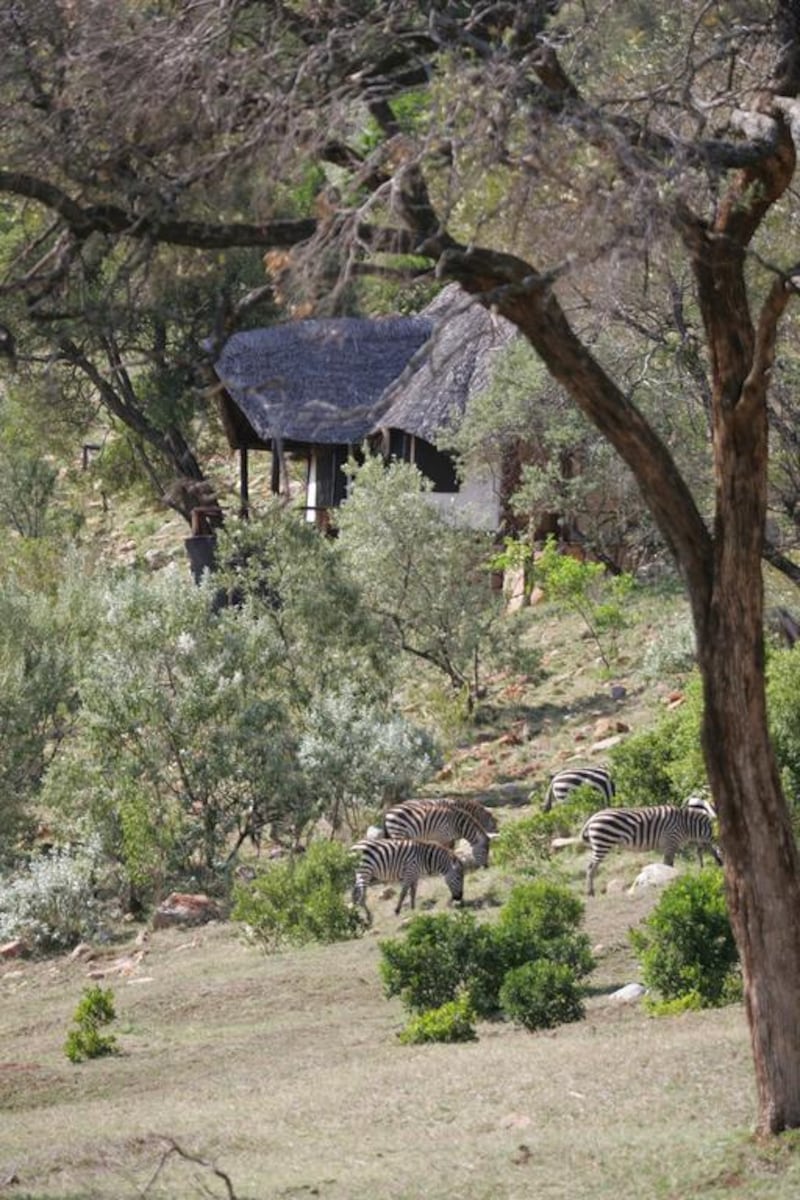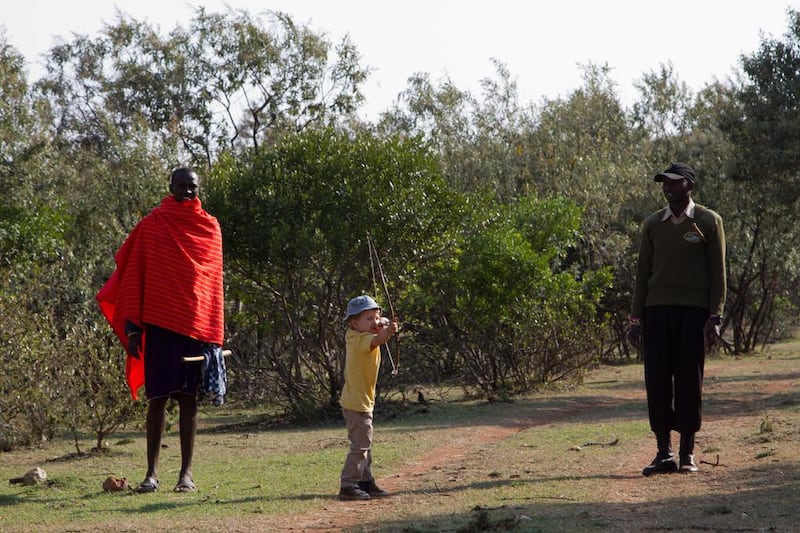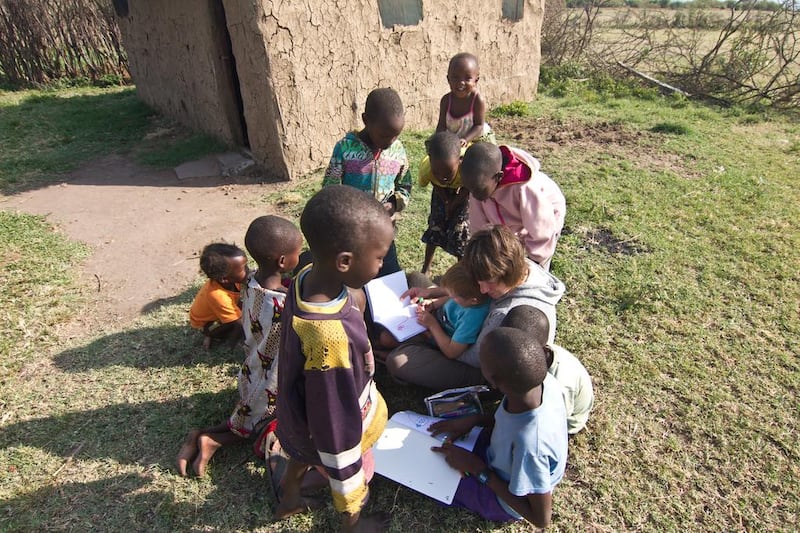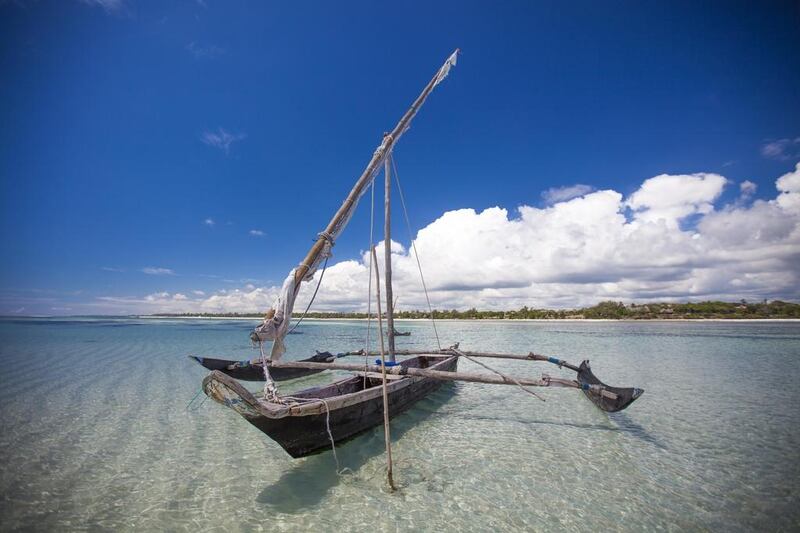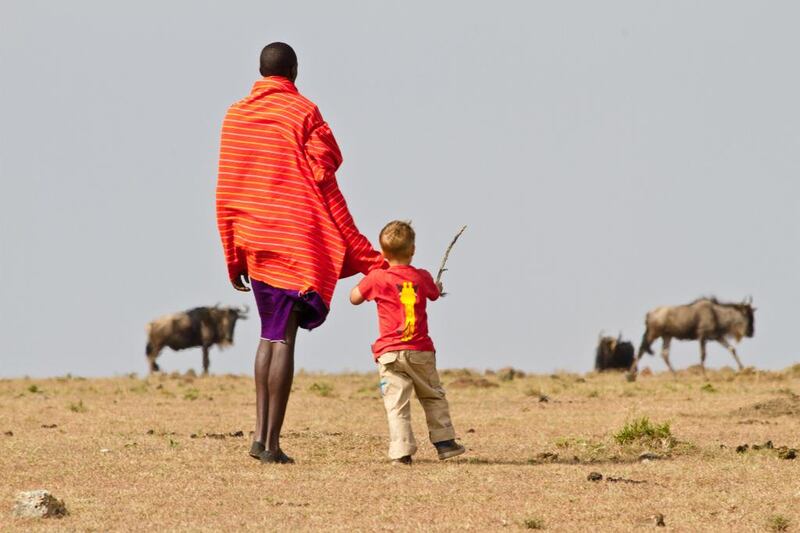As the first soft, tinged rays of dawn light creep into the darkened room, I sit up in bed. Hushed voices can be heard whispering outside. I’d slept badly that night, but perhaps that wasn’t surprising. It hadn’t been the barking of nervous dogs that had woken me in the night. Nor had it been the shouting of excited villagers. Even the panicked bleating and mooing of the goats and cows in the nearby thorn-tree enclosure hadn’t disturbed me too much. All those noises I found strangely comforting. What had woken me in the night, and stopped me sinking back into sleep, had been the realisation that a pride of lions hungry for cows had been prowling around outside our window. I looked down at my wife, still sleeping beside me, and my two children in their beds. None of them had even stirred when the lions had caused such a commotion outside.
Squeaking open the door of the mud-and-wattle hut in which we’re all staying, I step outside, and find despite the early hour, the Maasai manyatta (farmstead/village) is awake. Women, crouched beside brown cows with big eyes, are easing milk from bursting udders into cheap plastic cups. Half-dressed children skip through the dirt, while the men, in royal reds and purples, sit on a rickety, wooden bench and drink morning tea that tastes of wood smoke. Everybody is talking about the night’s close encounter of the big-cat kind.
There’s a part in many travel guidebooks entitled something along the lines of “Travel with children”. This normally consists of several pages extolling the pleasures of travelling with children and insisting that battling to get your little darlings out of the park/toyshop/queue for ice creams is so much more rewarding than actually going to see the place you just spent a lot of money getting to. Personally, I’ve long wondered if the people who write these parts of a guidebook have actually ever gone on holiday with a child. If they had, I’m pretty certain that most of these chapters would simply read: “Travel with children. Don’t. It’s rubbish.”
Despite my certainty in this matter, I have travelled with my children – Jake, 4, and Grace, 18 months – on many occasions. This meant when the opportunity arose to travel for a two-week safari in Kenya – an activity that involves long hours of sitting still and keeping quiet (neither of which my children are very good at). I was worried. Would the long journeys on dusty, hot, bumpy roads be too much for them? Would other lodge and hotel guests object to having a couple of noisy children racing around? Would they even be interested in seeing the animals?
It quickly became clear that if we were going to go on a family safari, we needed to pick our accommodation and choice of activities carefully. The golden-hazed savannahs of Kenya’s Maasai Mara national reserve is the Times Square of the animal world. Thousands of creatures, big and small, toothy and scary, mellow and vegetarian, cram on to these grassland plains.
At this time of year, the animal biomass swells thanks to the arrival of up to a million migrating wildebeest, zebras and antelopes from Tanzania’s neighbouring Serengeti National Park. Anyone, child or adult, visiting the Maasai Mara at this time will witness an exciting, non-stop Noah’s Ark of herbivores and carnivores.
There’s no shortage of accommodation in and around the Maasai Mara and surrounding private conservancies (essentially, these are private, very exclusive wildlife reserves) and we select two camps that seem to offer something for our children and for us. From the outset, though, I’m determined Jake and Grace’s Kenya adventure will be more than just privileged pampering in luxury lodges. And that’s how my family and I end up staying in a mud hut surrounded by cattle (and occasional feline visitors) enjoying the company of our Maasai hosts.
Our Kenyan safari begins at the opposite end of the spectrum from the Maasai manyatta. Cottar’s 1920s Safari Camp sits hours away from the nearest other safari lodge, on the brow of a gentle hill, in the private Ol Derikesi Conservancy on the far southeastern edge of the Maasai Mara. Calling Cottar’s a tented camp brings all the wrong sort of images to mind. There’s nothing primitive or uncomfortable about a stay here. The handful of well-spaced “tents” come with antique furnishings and luxurious bathrooms – pure 19th-century safari elegance. Despite it being a dream honeymoon setting, my wife and I are less concerned with romantic sunsets and more about what they can do to keep our children happy. The answer turns out to be quite a lot.
Jake is all wide-eyed wonder as Moses Kinyaika, a red-robed Maasai warrior with a spear, announces how, over the next couple of days, he’s going to turn Jake into a fully qualified Maasai warrior just like him. The first part of the course is to learn how to track wild animals. While Jake can barely control his excitement at the thought of following Moses and a lion into the bush, we quietly wonder if it’s possible to limit wildlife tracking to the less child-hungry creatures. A hedgehog perhaps? Or possibly a tortoise? From there on in, Jake is kept busy tracking animals, learning how to light fires without matches, grasping the finer points of bow and arrow use and various other activities that you don’t really want a 4-year-old boy learning.
Grace is considered too young to use a bow and arrow, but she enjoys painting herself red with the special plant extracts the Maasai use as a type of make-up, chasing the ever-entertaining vervet monkeys around the camp and splashing about in the pool.
It’s a similar set-up at our next stop, Saruni Mara, which is within the spectacular Mara North Conservancy; a place considered by many an experienced safari-goer to offer some of the best savannah wildlife-watching in all the continent. The lodge is perhaps even plusher than Cottar’s; the “tents” even come with open fireplaces as well as one of the most impressive settings – enclosed within lightly wooded hills busy with warthogs, zebras and buffaloes – in the Mara region. Saruni also offers a “warrior training” programme for the children, and it’s here Jake’s expertise with his Maasai-crafted bow and arrow really blossoms. The moment any animal is silly enough to show its face within his general vicinity, he announces with enthusiasm he’s going to shoot it, which probably isn’t the kind of conservation message the park authorities hope their visitors absorb. And if all the animals take cover? Well, having a little sister is always useful for target practice.
Going on a Kenyan safari is actually about seeing the wildlife on a game drive. Both Cottar’s and Saruni provide in-house babysitters, which means we often, but not always, leave Grace in their capable hands and just take Jake out on a drive with us. Naturally enough, his interest levels vary depending on the amount of action taking place. If there are lions or elephants padding about, he normally sits engrossed for five minutes or so. If the scary lions are doing nothing more blood-curdling than dozing under a tree, then five minutes is rather pushing it.
Fortunately, when the animal action slows down, we’re able to keep child boredom at bay with a stop for snacks, or better still, a bush breakfast. There’s nothing like sitting under an acacia tree eating sausage and eggs while surrounded by lazily grazing wildebeest to keep a child mesmerised. While game drives with the children are only moderately successful, bush walks, while rarely revealing as many big mammals as a game drive, are always a resounding hit. There are termite mounds to climb, elephant poo to dissect (or, if you’re an 18-month-old, try to eat), a jungle of plants with fascinating properties to discover and, best of all, the excitement of antelopes, zebras, giraffes and baboons fleeing on our approach.
As perfect as the lodges are, however, it’s our stay in the Maasai manyatta, where the tea tastes smoky and the cows moo through the night, that leaves the most lasting of memories. Yes, sleeping in a mud-and-wattle hut with no electricity or running water is hardly the stuff of holiday bliss, but for all of us, the experience of glimpsing into rural Maasai life is a privilege and an honour that no amount of safari pampering can possibly replace.
Days start at dawn and are spent helping to milk cows and goats, gather firewood, prepare meals and walk for hours with the Maasai and their cattle to the day’s grazing grounds.
Both children find themselves swept up in village life. Jake has a ready-made set of friends with whom he can rush around chasing goats, play football and roll about in the dust. Grace, meanwhile, has a small army of besotted local Maasai women at her beck and call, and, yes, she too becomes quite partial to chasing goats and rolling in the dust. Jake finds village life so fascinating that he even ends up attending classes at the one-room local primary school, where lunch is a bowl of maize-meal porridge and playtimes are occasionally interrupted by buffalo strolling past.
It’s something of a tradition for a Kenyan safari to finish with a few days’ relaxation on the salt breeze sands of the country’s Indian Ocean coastline. The beaches of Kenya, with their ever-warm, turquoise-hued waters and white sand as soft as marshmallows, seem tailor-made for the fun of youngsters.
We stay at Kinondo Kwetu, a small and exclusive resort south of Diani Beach. The handful of breezy, open-plan cottages here have Swahili accents and are centred around a swimming pool so big we can scuba dive in it (seriously). If, however, you prefer your swimming saltier, there’s also a semi-private beach, hidden from the world by coral cliffs and coconut trees that bend in the wind like dancing giraffes.
When we arrive at the coast, we’re full of big ideas of all the things we’re going to do: day trips to the steamy city of Mombasa, nature walks through mangrove swamps and a visit to a colobus monkey sanctuary. As it happens, though, Kinondo Kwetu is a veritable activity centre.
As well as learning to scuba dive, in the pool and the more fish-friendly ocean, there’s horse riding, kayaking, windsurfing, fishing and boating. So much is on offer, all thoughts of exploring the backstreet markets of Mombasa blow away on the spice-laden monsoon winds, and our last days in Kenya are instead spent self-indulgently eating barbecued fish, searching for crabs in the low-tide rock pools and building sandcastles.
Resting in the shade of a coconut tree on our last afternoon in Kenya, I reflect on travelling here with young children. It would be a lie to say it has all been plain sailing, but I have to admit, if I were writing the section of a travel guidebook entitled “Travel with children”, I would probably write: ‘Travel with children. Don’t. It’s rubbish. Unless you’re on safari in Kenya’.
weekend@thenational.ae
Follow us @TravelNational
Follow us on Facebook for discussions, entertainment, reviews, wellness and news.
